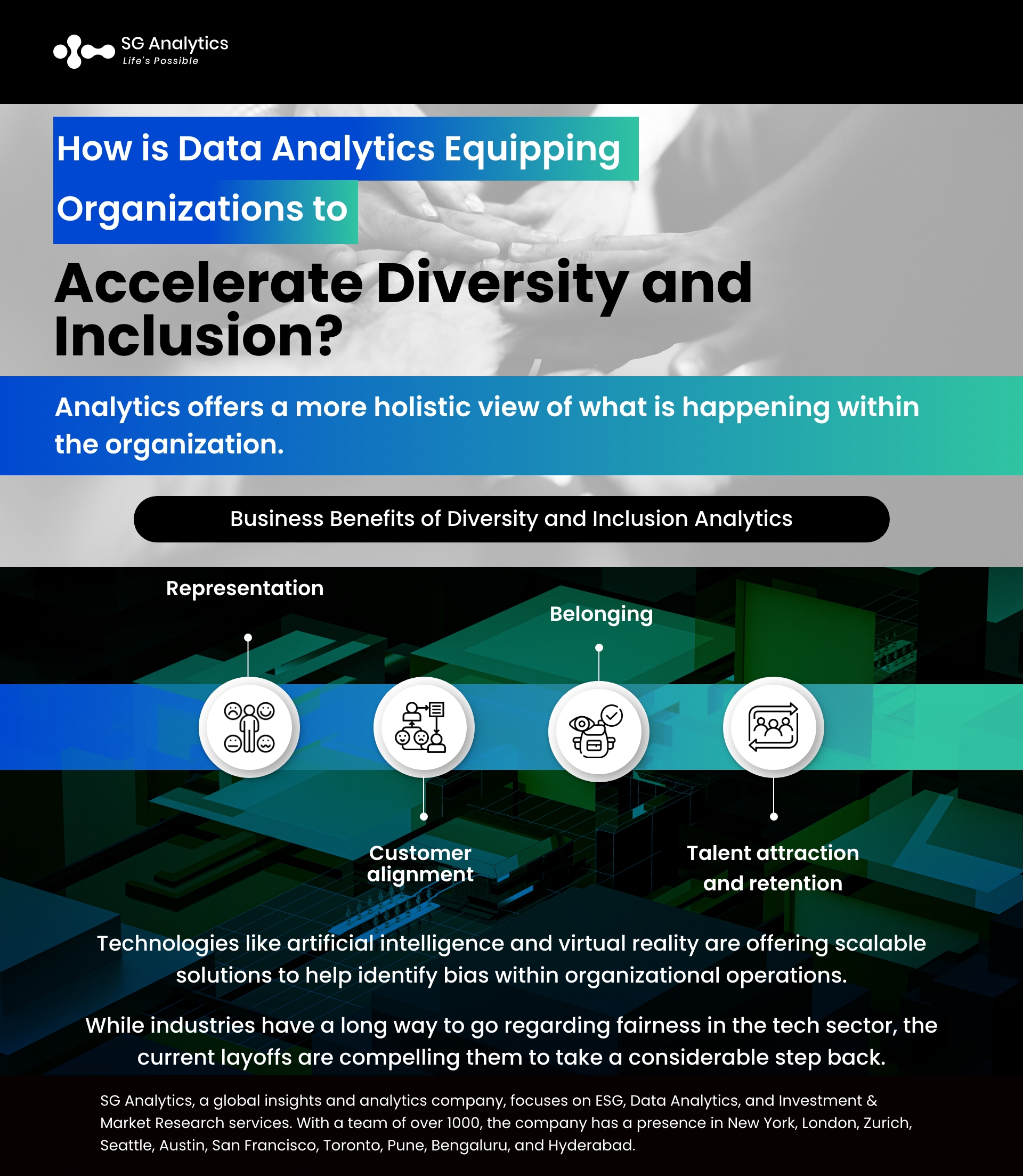A recent Bloomberg Gender-Equality Index identified that out of 484 large companies, only 41 have a female CEO, and 50 have a female chairperson. And 32% of boards are occupied by women. In the last few years, organizations have witnessed an increase in diversity in management positions. Organizations have witnessed an increase in women in management roles, but women of color remain significantly underrepresented. PwC data showcased that out of the 26% of women in the C-suite, only 5% of those leaders are women of color. While the scenario is changing, organizations still have a long way to go to achieve diversity in management ranks.
Today we have tools to help boost efforts and achieve more gender equality. Emerging technologies and approaches are enabling industry leaders to help raise awareness of where more work is needed and open new opportunities.
Data and analytics serve as an instrument to help estimate progress and identify areas of concern. The accumulated data is helping to boost opportunities and gain clarity on where drop-off points are occurring in the pipeline for diverse talent. It also provides insights on where to focus on making meaningful change.
Read more: Business Outlook In 2023: Data Compliance and Data Security & Pipelines

Digital technology plays an equally significant role, from enhancing connectivity and upskilling opportunities to broadening talent pools with remote work. It helps in creating more transparency in the data to generate actionable insights. Hybrid work and online collaboration tools are helping organizations to retain their top talent and attract diverse candidates. Technologies like artificial intelligence and virtual reality are offering scalable solutions to help identify bias within organizational operations and promote consciously inclusive behaviors to increase accountability.
The visibility of data analytics is shining bright on companies’ diversity by presenting guided efforts for growth. Technology is making it more accessible for industry leaders to understand the talent lifecycle as well as identify specific opportunities for improvement in the processes. They are developing new frameworks to attract and retain diverse talent that can be prepared for management roles. These insights from data analytics are enabling organizations to help train leaders and cultivate more inclusive environments for diverse talent to thrive.
Business Benefits of Diversity and Inclusion Analytics
In today’s business climate, industry leaders are hard-pressed to create a culture that integrates diversity, equity, and inclusion (DE&I) as a business priority, a goal, and a differentiator for the organization. By providing a focused area for improvement, organizations are focusing on establishing diversity, equity, and inclusion to build workplaces representative of our world. Investments in diversity, equity, and inclusion are also offering a well-documented relationship to business performance and profits.

By incorporating diversity and inclusion together, businesses are creating new benefits. Some of these include:
Read more: Integrating Data and Artificial Intelligence in Business Strategy to meet ESG Goals
-
Representation
Fostering a culture in a company where equity lies at the core value and diversity is representative of the communities will help in presenting the moral compass of the organization and its reputation at large.
-
Customer Alignment
To extend community alignment, it is important for businesses to have a company representative of their customer base. It will be beneficial and help in delivering better products, branding, and pitches.
-
Belonging
Creating a sense of belonging helps in fostering a positive culture that yields results for individual employees, teams, and the organization. This can be quantified by a commitment to increase the net promoter score as well as the total lifetime value of an employee.

-
Talent Attraction and Retention
With equitable HR programs and talent attraction, the employer brand will be able to cultivate a diverse work environment and generate the outcomes they are looking for.
Data and Analytics: The Key Driver for Growth
Data and analytics today form the centerpiece of any digital business transformation strategy. And with the need to drive diversity and innovation within the organization, data analytics is finding a new place in every operation
Analytics is more than a metric. It is all about having some context for thinking about what's happening and what to do next. It is important that the generated information makes the right sense to people within. Having the right information helps in telling a clear story and is the first step to identifying where the organization is and what is happening.
Companies are trying to address the inequalities in workplaces in numerous ways. They are creating new frameworks to offer employees a space to come together over shared interests. However, one of the biggest problems with making real progress is transitioning beyond performative allyship and breaking the surface. While it is easy to say that we support and value all employees equally, real challenges arise while putting the words into action.
Read more: Leveraging Data Analytics in Business and Finance to Drive Growth

Creating an Inclusive Work Culture
One of the significant steps involves retaining and developing the hired talent. Industry leaders are now practicing an inclusive leadership style to keep their teams motivated and invested. It is equally important to make the employee feel safe when they speak up or voice new ideas and are empowered to make their own decisions. Organizations also need to create a framework for mentoring and peer programs to diversify their culture at all levels.
Today, the importance of diversity within research extends beyond opportunities. It surpasses individual perspectives and thought and helps in recognizing the creativity, knowledge generation, and problem-solving skills that can be approached from a multitude of directions. And with data analytics, organizations can generate new insights that help in assessing where the organization is and explore new areas for improvement for better results. But organizations will have to put in efforts to enhance their diversity, equity, and inclusion and present new opportunities for their talent.

To overcome the challenges, businesses are identifying the gender and other forms of diversity gap, enabling leaders to think of strategies to retain and manage people from diverse backgrounds while fostering a culture of inclusion. Data and analytics leaders should now work towards attracting, growing, and leveraging talent to optimize business outcomes.
Read more: Trends in Big Data Analytics: Forecast for 2023
What can Analytics tell how People are doing in the Organization?
Analytics offers a more holistic view of what is happening within the organization. It presents a picture of who is joining, who is leaving, why is the existing talent leaving, who is advancing, and the diversity of leadership. It also assists in identifying the existing trends and what the data will look like in the next few years.
Once they have a clearer picture, they can start integrating new ideas based on the related data. If the organization witnesses many women employees leaving a certain department, it can look at the reasons provided and then identify the factors. It is also important to understand the quality of the data being used. Understanding what data is missing or incomplete will enable industry leaders to build the quality of their data and trust the information being presented.

Making progress with diversity, equity, and inclusion is not easy. It begins with an analytics-based approach. By integrating the right data analytics framework, leaders can identify the existing gaps and areas of opportunity across the organization. While building a deeper DE&I analytics capability is vital, it involves the ability to make ties across the data and systems. However, it does mandate a deep dive into hiring and recruitment data alongside turnover to discover biases or gaps in the process.
Organizations will be able to see and point out where things look good across different categories and where they may have to increase efforts to improve diversity and inclusion. With the right analytics and insight, they can not only guide decisions and actions but also make a difference - within the companies and throughout the communities.
With a presence in New York, San Francisco, Austin, Seattle, Toronto, London, Zurich, Pune, Bengaluru, and Hyderabad, SG Analytics, a pioneer in Research and Analytics, offers tailor-made services to enterprises worldwide.
SG Analytics - Leading US-based Insights & Research Company that focuses on leveraging data management & analytics, and data science to help businesses discover new insights and build strategies for business growth. Contact us today if you are looking to make critical data-driven decisions to prompt accelerated growth and breakthrough performance.









